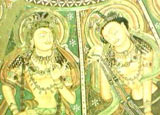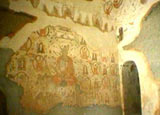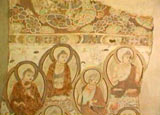 |
|
Kumutula |
| CCTV.COM 2003-12-09 16:12:15 |
|
 Before the third century, Buddhism was introduced into the Kingdom of Qiuci of China’s Western Regions from India and Central Asia. The Kumutula grotto murals in Kuqa, Xinjiang Uygur Autonomous Region may be rated as a treasure-house of Buddhist art in China. Before the third century, Buddhism was introduced into the Kingdom of Qiuci of China’s Western Regions from India and Central Asia. The Kumutula grotto murals in Kuqa, Xinjiang Uygur Autonomous Region may be rated as a treasure-house of Buddhist art in China.
The Kumutula Grottoes were built in the fourth century. Most of the murals in the grottoes depict stories of Buddhist scriptures in the ancient Qiuci style. The unique style ingeniously mixed together the images of figures in the Western Regions, exquisite decorative patterns and intricate line drawings.
In A.D. 684, the Tang Empire took control of Qiuci in the Western Regions and established the Anxi Protectorate. After that, the government of the Tang Dynasty built grottoes and temples in Kumutula, bringing ideas of Mahayana and mural art of the Han and Tang dynasties to the locality. Kumutula entered a period of the coexistence and common development of Qiuci Buddhism, Central Plains Buddhism, Qiuci murals and Han-style murals.
 “It was a place under the jurisdiction of Hexi Protectorate. Many Han Buddhist monks came here. Many Han soldiers were stationed in the border region. They needed to enshrine and worship images of Buddha. They also needed halls for worshipping Buddha. Some Han Buddhist monks wanted to sit in meditation here. In those days, the Han culture produced an important influence. Kumutula was an early transition between Kezi’er Grottoes and Dunhuang,” said Liu Xilin, director of Research Department of China Art Gallery. “It was a place under the jurisdiction of Hexi Protectorate. Many Han Buddhist monks came here. Many Han soldiers were stationed in the border region. They needed to enshrine and worship images of Buddha. They also needed halls for worshipping Buddha. Some Han Buddhist monks wanted to sit in meditation here. In those days, the Han culture produced an important influence. Kumutula was an early transition between Kezi’er Grottoes and Dunhuang,” said Liu Xilin, director of Research Department of China Art Gallery.
The Han-style murals painted in those days showed the style of the Central Plains in respect of their subject matters and painting skills. Many of the murals portrayed stories of Buddha and stories of Buddha’s previous incarnation. The stories of Buddha mainly depicted the life of Sakyamuni. The stories of Buddha’s previous incarnation, vivid and philosophical, represented the virtues of Buddha before reincarnation. Painters in ancient times resorted to succinct composition when they portrayed main plots of the stories, so their works were of great artistic appeal.
“Besides the origin of Buddha, there is difference between Mahayana and Hinayana. Buddhist stories contain many illusory myths and colours. They presented different identities, stories and experiences of deities,” said Liu Xilin, director of Research Department of China Art Gallery.
 After the 9th century, the brave and battle wise Huihu people began to establish their political power in Qiuci. On the basis of the Qiuci and Han-style murals in the Kumutula Grottoes, the Huihus created robust and elegant images of Buddha to their own liking. The bright-colored murals gradually replaced the original Han-style murals. After the 9th century, the brave and battle wise Huihu people began to establish their political power in Qiuci. On the basis of the Qiuci and Han-style murals in the Kumutula Grottoes, the Huihus created robust and elegant images of Buddha to their own liking. The bright-colored murals gradually replaced the original Han-style murals.
For many centuries, murals of the Qiuci, Han and Huihu styles have existed in harmony. The subject matters, artistic forms and painting skills of the murals in Kumutula represent the political, economic, ethnic, cultural and religious developments in the Western Regions between the 5th century and the 11th century. They provide a rich and colorful picture scroll of the history of the Western Regions.
|
|
Editor: Han Ling CCTV.com
|
|
|
|
|
|
 |









